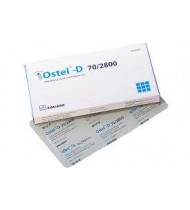Alendronic Acid + Vitamin D3
Indications
Alendronic Acid & Vitamin D3 is indicated in:
- Treatment of osteoporosis in postmenopausal women.
- Treatment of osteoporosis in men.
- Treatment of osteoporosis as it increases the bone mass and reduces the incidence of fractures, including those of the hip and spine.
Pharmacology
Alendronate Sodium is a bisphosphonate that acts as a specific inhibitor of osteoclast mediated bone resorption. Alendronate is effective when administered at least 30 minutes before breakfast. It transiently distributes to soft tissues following administration but is then rapidly distributed to bone or excreted in the urine. Protein binding in human plasma is approximately 78%. There is no evidence that Alendronate is metabolised in animals or humans. At the cellular level, Alendronate shows preferential localization to sites of bone resorption, specially under osteoclasts. It inhibits osteoclast activity. In addition, bone formation exceeds bone resorption, leading to progressive gains in bone mass. Vitamin D is required for normal bone formation. Vitamin D insufficiency develops when both sunlight exposure and dietary intake are inadequate. Insufficiency is associated with negative calcium balance, increased parathyroid hormone levels, bone loss, and increased risk of skeletal fracture.
Dosage
Treatment of Osteoporosis in Postmenopausal Women: The recommended dosage is-
- 70 mg alendronate and 2800 IU vitamin D3 or
- 70 mg alendronate and 5600 IU vitamin D3 tablet once weekly.
- For most osteoporotic women, the appropriate dose is 70 mg alendronate and 5600 IU vitamin D3 once weekly.
- 70 mg alendronate and 2800 IU vitamin D3 or
- 70 mg alendronate and 5600 IU D3 tablet once weekly.
- For most osteoporotic men, the appropriate dose is 70 mg alendronate and 5600 IU vitamin D3 once weekly.
Administration
To permit adequate absorption, Alendronate & Colecalciferol must be taken at least 30 minutes before the first food, beverage or medication of the day with plain water only. Other beverages (including mineral water), food and some medications are likely to reduce the absorption of Alendronate. To facilitate delivery to the stomach and thus to reduce the potential for esophageal irritation, Alendronate & Colecalciferol tablet should only be swallowed upon rising for the day with a full glass of water. Patients should not lie down for at least 30 minutes after taking Alendronate until after their first food of the day. Alendronate & Colecalciferol should not be taken at bed time.
Interaction
Calcium supplement, antacids and some oral medications will interfere with absorption of Alendronate if taken at the same time. Intravenous ranitidine makes the bioavailability of oral Alendronate double. Incidence of upper gastro-intestinal adverse events associated with NSAID and aspirin appears to be greater with concomitant administration of Alendronate. Mineral oils, orlistat, and bile acid sequestrants (e.g., cholestyramine, colestipol) may impair the absorption of vitamin D. Anticonvulsants, cimetidine, and thiazides may increase the catabolism of vitamin D.
Contraindications
- Abnormalities of the esophagus which delay esophageal emptying, such as stricture or achalasia.
- Inability to stand or sit upright for at least 30 minutes.
- Hypersensitivity to any component of this product.
- Hypocalcaemia.
Side Effects
Usually mild and generally do not require discontinuation of therapy. Side effects include esophageal reactions, abdominal pain and distension, diarrhoea or constipation, flatulence, musculoskeletal pain, headache, rash, erythema and transient decreases in serum calcium and phosphate.
Pregnancy & Lactation
Pregnancy category C. Overdoses of vitamin D have shown teratogenic effects in pregnant animals. Alendronic Acid & Vitamin D3 (Colecalciferol) should be used during pregnancy only if the potential benefit justifies the potential risk to the mother and fetus. Cholecalciferol and some of its active metabolites pass into breast milk. It is not known whether alendronate is excreted in human milk. Caution should be exercised when administered to lactating women.
Precautions & Warnings
Hypocalcaemia and other disturbances of mineral metabolism should be corrected before initiation of therapy. Alendronate can cause local irritation of the upper gastro-intestinal mucosa. Caution should be used when Alendronate is given to patients with active upper gastrointestinal problems such as dysphagia, esophageal disease, gastritis, duodenitis or ulcers. Patients should stop taking medicine and consult their physician if they develop esophageal diseases.
Use in Special Populations
Dosing in elderly and renal insufficiency: No dosage adjustment is necessary for the elderly or for patients with mild-to-moderate renal insufficiency (creatinine clearance 35 to 60 mL/min). Alendronic Acid + Vitamin D3 (Colecalciferol) is not recommended for patients with more severe renal insufficiency (creatinine clearance<35 mL/min) due to lack of experience.
Overdose Effects
Hypocalcemia, hypophosphatemia, and upper gastrointestinal adverse events, such as upset stomach, heartburn, esophagitis, gastritis, or ulcer, may result from oral overdosage. Signs and symptoms of vitamin D toxicity include hypercalcemia, hypercalciuria, anorexia, nausea, vomiting, polyuria, polydipsia, weakness, and lethargy.
Therapeutic Class
Combined preparations: Inhibiting bone resorption
Storage Conditions
Store in a cool and dry place. Protect from light & moisture. Keep out of the reach of children.
Ostel-D Tablet 70 mg+2800 IU
IndicationsAlendronic Acid & Vitamin D3 is indicated in:Treatment of osteoporosis in postmenopau..
30.20Tk.
Ostomax D Tablet 70 mg+2800 IU
IndicationsAlendronic Acid & Vitamin D3 is indicated in:Treatment of osteoporosis in postmenopau..
25.00Tk.
Showing 1 to 2 of 2 (1 Pages)


